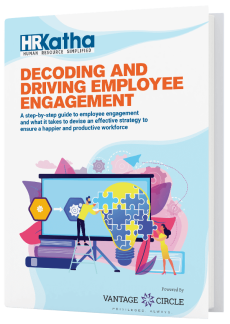7 Best Ways To Increase Employee Survey Participation Rates

Any company that cares about its employees knows how vital employee surveys are. But employee survey participation rates are a big pain-point for companies far too often.
We get it. Employees find surveys a great hassle to undertake.
Traditional employee surveys had the bad reputation of being long, dull, and tedious. As a result, the disinterest is reflected clearly in the low survey response rates.
In this age of technology, HR teams are coming up with agile solutions to engage their workforce. By far, the most cost-effective tool to know what the people want out of the company is employee surveys.
Employee engagement surveys are pivotal to measuring the levels of engagement in the company.
A simple employee survey can bring forth your current company culture's strengths and weaknesses if done right.
However, the success of any engagement survey depends mainly on the number of participants. The more number of participants means getting accurate survey results that capture diverse opinions.
However, fewer respondents mean getting data that is disconnected from the majority of the workforce.
Thus, it's high time that companies learn what drives an employees' motivation behind taking a survey. Also, how to ensure that the feedback they give is genuine?
In this article, we'll be looking at ways to increase your overall employee survey participation rates. So, let's get started.
7 Tips To Increase Employee Survey Participation Rates
People want to feel comfortable and relevant while taking part in an employee survey. Seven such ways to provide the best employee feedback experience are outlined below.
1. Award Incentives To Complete The Survey
Everybody likes to be rewarded. Employees consider the act of receiving rewards and recognition as being pivotal to their work experience. The act of receiving incentives for taking a survey has two main aims:
- Firstly, employees feel like their feedback is valuable.
- Secondly, the incentives inspire more employees to join the survey.
Employees get rewarded for investing their time. Meanwhile, the company receives the benefit of having a larger pool of survey participants. All in all, it is a win-win situation.
Some great incentives to tie to the action of completing a survey can be in the form of:
- Gift cards
- Reward points
- Day off
- Spa days
- Donate to a charity
- Plant a tree
… and many more. We have already curated a whole list of unique rewards and recognition ideas that you can take inspiration from.
2. Accessibility Of The Survey
Today’s workforce is tech-savvy by nature and wants things to happen as quickly as possible. However, traditional surveys are known to be manual and thus are considered tedious to complete.
Even modern online surveys face the constraints of being only available at a specific desktop setting, making the process of taking a survey incredibly inconvenient.
If your company continues to follow the same practices, your employee participation in the survey may have taken a hit.
To see higher employee survey responses among the “digital natives,” it’s essential that the survey is accessible to all.
Seeing that most of us are working remotely post-2020, the need for survey accessibility grows more vital. Here is what it actually means:
Multi-Device Accessibility
Employees of today are always on the move and use their smartphones more than ever. Thus, any employee survey should consider making the survey more accessible by optimizing it for mobile, tablet, desktop, etc.
Multi-platform Accessibility
Only optimizing your survey for a particular platform should be largely avoided. To make your surveys as user-friendly as possible, enable people to take surveys from multiple platforms such as Android, iOS, Windows, etc.
Multi-Language Support
With diversity and inclusion being so crucial to today’s workforce, your surveys should reflect the same. Provide the option of multi-language support to ensure that your global workforce doesn’t feel left out from voicing their opinions.
Disability Access
Ensure that your surveys are easy for disabled people to use and navigate. That might include providing some extra functionalities such as voice-to-text. But the cost is justifiable if it makes your workforce feel valued, included, and happy.
3. Optimize The Survey Length
As mentioned earlier, the employees of today are incredibly pressed for time. With the stress of projects, work-life balance, and meetings, the time to take a long survey is far from ideal for them.
Optimizing the survey length is one of the most effective ways to increase your employee survey response rates. People will inevitably respond better to a survey that is brief and to the point.
On the other hand, companies are also going to benefit from such short surveys. Short surveys help leaders to frame relevant questions that reflect the key challenges in the workplace.
Unlike popular perceptions, long surveys do manage to fit in more questions, but the results will be skewed. The theory is that the longer the survey is, the more likely it is for workers to get impatient and only offer arbitrary answers.
4. Optimize The Survey Questions
A survey should be incredibly user-friendly to help you get relevant employee feedback from a much more diverse pool. Thus, ensure that while framing survey questions, you keep the following criteria in mind:
Clear Meaning
The survey questions should be framed so that every employee interprets the meaning after reading the question. Unless this occurs, the reliability of the survey response rates can be doubtful and inconclusive.
Easy Language
The language used for survey questions should be clear, concise, and straightforward. Try not be make it too complicated because the changes of misinterpretation will grow bigger.
Avoid Open-Ended Questions
The "yes" and "no" questions that many employee surveys use- make it challenging to measure employee engagement levels.
A better alternative is to opt for an eNPS driven survey that allows answering survey questions with a range of either 0-5 or 0-10. eNPS is arguably the more efficient way of measuring relevant metrics without overwhelming the survey respondents.
5. Create A Survey Communication Action Plan
This is a highly essential step that employers mostly ignore. A survey communication strategy is highly critical to maximizing employee survey participation rates.
Here is what a good survey communication action plan looks like:
Pre-Survey Communication
Most of the time, employees are unaware of what the survey is about. You must convey the following survey details to your employees clearly and concisely:
- The aim of the survey
- How the outcome of the survey will be utilized
- If there are any incentives tied to complete the survey
- How, when, and where the survey can be taken
Additionally, remember to promote the survey extensively so that every person in the company is made aware of it.
During The Survey
Be ready to offer any technical assistance or support while employees take the survey. This will ensure that employees take the survey seriously and also aid in providing a hassle-free survey experience. Thus, people will feel less stressed about having to take the survey again in the future. As a result, your employee survey participation rate will see a significant boost.
Post-Survey Communication
After the survey is over, it's important to communicate with the people who were part of the survey. Ask the survey respondents if there are ways to improve their experience and if they encountered any difficulties.
Often, communicate and discuss the survey findings and your action plan for resolving the issues with your workforce.
It will help to build trust between you and your employees that you take employee feedback seriously.
6. Act-On The Employee Feedback Given
Employees don't like to participate in surveys because companies rarely act on the given feedback.
Employees see surveys as being a meaningless corporate exercise that doesn’t require genuine involvement.
To improve employee survey participation rates, it’s essential to let employees know and see that the company is proactively working to improve the workplace experience.
Doing so will build a trust and transparency culture where employees will feel empowered to offer their own opinions and ideas to others.
Ultimately, such practices of supporting workers to offer opinions and acting upon them will improve employee engagement.
7. Anonymity Matters
Another critical aspect that motivates employee survey participation enables people to be anonymous. Without this anonymity, employees are less likely to give their honest views and opinions out of fear of repercussions.
Anonymous surveys would allow workers to share their views without any hesitation. When surveys are made anonymous, workers consider contributing. Thus, It enables you to obtain reliable data and feedback about how workers interpret the company’s culture.
Finally
Is there any additional way to improve employee survey participation rates? Do let us know in the comments below.

Vantage Circle is a simple AI-powered Rewards & Recognition Platform for upgrading your employee experience and engagement for better productivity.





